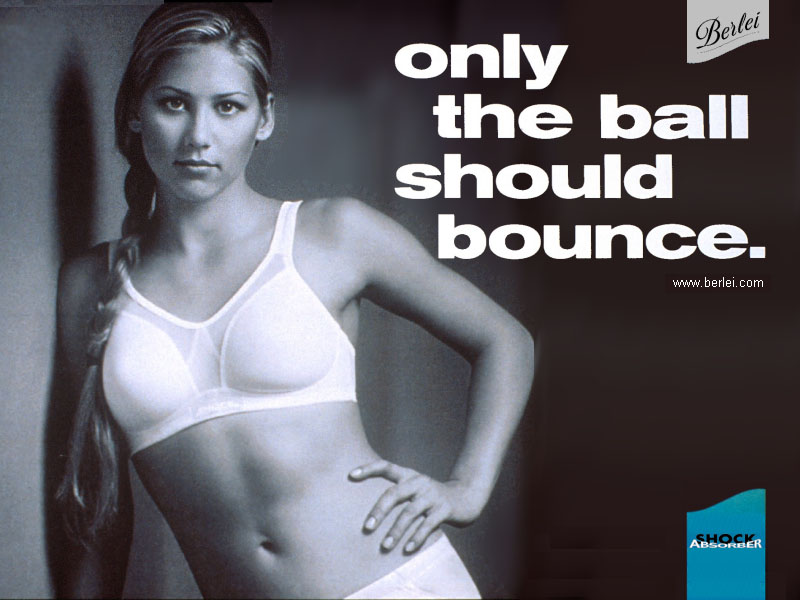Women's Tennis: The Marketing Model
by Daniel Mitha
Produced for the Web by Aparna Surendran

Few were shocked when Anna
Kournikova dressed down for her Berlei Shock Absorber
sports bra ad |
Londoners caught a glimpse of the future of
sports entertainment last summer when they tilted their heads
skyward at a billboard that featured a fresh-faced woman with
Rapunzel-esque blonde locks wearing a coy smirk and a snugly
fitting sports bra. The cheeky caption read: "Only The Ball
Should Bounce."
Who was this babe? A model, handpicked by Berlei execs
for her flawless skin and cerulean eyes? Maybe an XFL cheerleader
kicking off the coming wave of hype for the upstart football
league? The billboard beauty was Russian vamp Anna Kournikova,
currently the 9th ranked player in professional women’s
tennis.
Undeniably the largest and most lucrative of professional
women’s sports, tennis provides an apt marketing model from
which other women in sport will take their cues. And, even
in these gender-enlightened times, when beauty alone does
not confer privilege, it still goes far enough: From here
to the bank.
Tennis fans, though, are not accustomed to seeing their
icons in a blatantly sexualized light. But a palpable audience
thirst for entertainment combined with its love for the
sport demands more from its stars. The WTA (Women’s Tennis
Association), many of its players and sponsors, and Hollywood,
too, are ready to oblige. "We are promoting great athletes,"
says WTA president Bart McGuire, "and we make no apologies
for the fact that many of them are attractive as well."
| "...
me and Anna and Venus. We're the Spice Girls of tennis." |
So
attractive are some of the WTA’s players and so hefty their
star-power that they have crossed
over to a mainstream audience. Top-ranked Martina Hingis
appeared on a 1999 cover of GQ
in a sequined white gown. Annie Liebovitz shot sisters Venus
and Serena Williams for a spread in Vogue
while Kournikova made People
magazine’s 1998 list of the 50 most beautiful people in
the world.
"I’m
for sale!" boasted Hingis in a 1998 edition of the Australian
Financial Review. "It’s business that wants this from
us and we’re playing the game, me and Anna and Venus. We’re
the Spice Girls of tennis."
Michael Wolf, head of media and entertainment at consultant
Booz-Allen & Hamilton, applauds tennis’s new guard. "They’ve
come out of the woodwork and out of uniform, and they’re
attending the music awards, getting photographed at the
right parties, and selling everything from make-up to computers.
They’re more accessible than the supermodels, they make
better role models, and this is what transforms athletes
into brands."
"Celebrity," he says, "is the universal currency and they’re
going after it."
NEXT:
A Good Script for the Price>>
|



